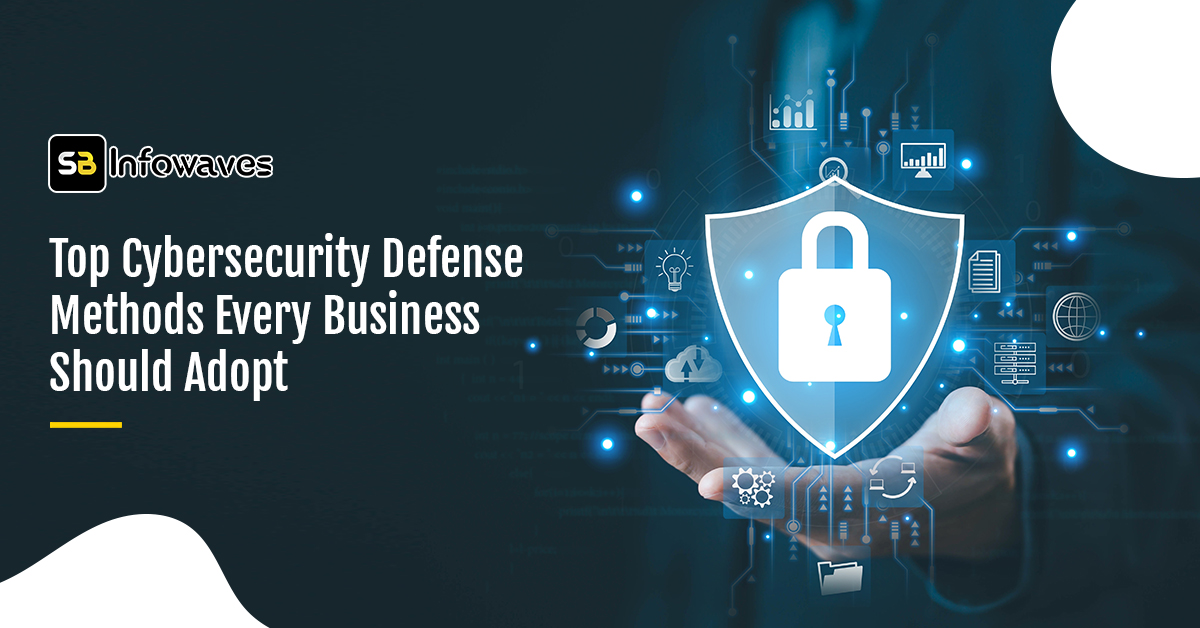
- Oct 04, 2024
Top Cybersecurity Defense Methods Every Business Should Adopt
Remember when the scariest thing about running a business was a grumpy customer? Well, times have changed, and now we've got cyber crooks to worry about too. But don't panic!
We're here to talk about some practical ways to keep your business safe in this digital jungle.
From robust firewalls to employee training programs, we'll cover the most effective strategies to safeguard your business against cyber attacks. In this case, as the best AI and ML company in Kolkata, we can guide you to shield your company against cybersecurity attacks.
SB Infowaves understands the critical role of advanced technologies in enhancing cybersecurity. Additionally, with an ISO/IEC 27001:2022 certification, our ability to combat cyber threats has been enhanced by providing a comprehensive framework for information security management, which ensures systematic protection of sensitive data and bolsters overall cybersecurity risk assessment skills.
Cybersecurity Risks— Understanding in detail
According to the ITRC Annual Data Breach Report, data breaches have grown up to 72% since 2021. Thanks to advanced technology, companies across the world can upgrade their security measures easily, but malicious hackers also use that technology to reduce cybersecurity risks.
Phishing Attacks
Hackers use deceptive tactics to fool people, so they make us disclose sensitive information, including financial information and passwords. They mainly target human weaknesses rather than technological issues.
For example, they usually do this by sending fake emails or messages that seem to come from trusted sources, such as banks or popular companies. Once someone clicks on a link or downloads an attachment in these fake messages, they may unknowingly give away personal data or install harmful software on their device.
Insider Threats
This type of cybersecurity attack is mainly posed by someone with access to an organisation’s network and may misuse that to harm the company. This type of threat compromises a variety of information, such as login credentials, customer and employee data, financial records, details about security practices, and intellectual property rights.
Malware & Ransomware
Both malware and ransomware are types of harmful software that compromise systems and data. Ransomware is a type of harmful software that locks or blocks access to data or systems. Attackers hold this information hostage and demand a payment, or ransom, to release it.
Nowadays, cyberattackers are modifying their methods, tactics, and procedures to exploit online vulnerabilities. Since modern technologies such as the Internet of Things (IoT) and cloud computing have interconnected natures, companies must adjust their cybersecurity process accordingly.
Risk Treatment Options—What is It and When to Leverage Them?
Risk treatment is an effective element of the cybersecurity strategy of a company that helps to manage identified risks, from reducing the impact of a risk to entirely eliminating it. Companies should choose the most effective cyber risk treatment option based on different factors, including,
- The organisation’s risk tolerance
- The nature of the risk
- The potential impact on operations
The main 4 primary risk treatment options are:
Risk Avoidance
In this strategy, experts recommend removing the actions that may expose the organisation to particular cyber risks. In that case, the employees should follow specific practices such as restructuring procedures to eliminate exposures to particular threats and foregoing certain technologies. Risk avoidance is suitable when a risk's impact is too high and the activity isn't crucial. For example, avoiding vulnerable software, though it may limit operational flexibility, does ensure security from cybercriminals.
Risk Reduction
Risk reduction means taking steps to lower the chances or impact of a risk. This can include:
- Using technical tools
- Improving processes
- Training employees
It's used when a risk can’t be avoided but can be managed to an acceptable level. For example, an organisation might use email filters and provide security training to reduce phishing risks. This approach helps maintain security while keeping regular operations running smoothly.
Risk Transfer
Risk transfer means shifting the financial impact of a risk to a third party, often through insurance or outsourcing. It's useful when an organisation wants to avoid the financial losses of a risk without reducing its chances.
For example, cybersecurity insurance can cover costs from a data breach, while outsourcing data storage to a cloud provider transfers the risk of data loss to the vendor responsible for security.
Risk Acceptance
Risk acceptance means you have to acknowledge the existence of a risk and still not take any actions to reduce it. The main reason is whether the potential benefits are minimal or the cost outweighs the benefits. This is approachable when the risk does not threaten the organisation’s operations and the cost is much more expensive relative to the potential impact.
Strategies Companies Should Take to Mitigate Cybersecurity Risks
With so many strategies, it can be overwhelming to choose the appropriate one. There are a few strategies companies should implement to reduce risks, including incident response planning and multi-factor authentication.
To Eliminate the Risk of Ransomware Attack
There is no doubt that ransomware poses several risks, such as operational disruption, data loss, reputational damage, financial costs, and potential regulatory penalties. That’s why companies should encrypt important files which also recovers data and restores the system.
Regular Backups and Backup Security
- Perform frequent backups of critical data
- Store backups securely offline, disconnected from the primary network
- Regularly test the backup restoration process
Patch Management
- Keep all software, applications, and operating systems updated and patched
- Conduct regular vulnerability assessments
- Remediate identified network weaknesses
Network Segmentation
- Segment the network to limit potential ransomware spread.
- Isolate critical systems from general user systems.
- Enforce strict access controls and least privilege policies.
Incident Response Planning
- Develop a well-defined incident response plan for ransomware attacks.
- Include steps for containment, eradication, and recovery.
- Conduct regular tabletop exercises and simulations.
Threat Intelligence and Monitoring
- Implement continuous monitoring of network traffic and behaviour.
- Look for signs of ransomware activity.
- Utilise threat intelligence feeds to stay informed about the latest ransomware tactics.
To Reduce Phishing Attacks
Phishing and social engineering attacks pose significant threats to organisations, which result in unauthorised access to sensitive data, financial fraud, and compromised user credentials.
The fallout from such breaches can be extensive which may include:
- Organisations may suffer substantial monetary losses due to fraud or theft.
- Business processes can be severely interrupted.
- Companies may experience privacy violations and potential legal issues.
- Affect relationships with customers, partners, and stakeholders.
- Companies may face hefty fines and penalties for non-compliance with data protection regulations.
To effectively combat these risks, organisations need to implement a multi-faceted defence strategy. This approach should encompass.
Implementing Cybersecurity Technology and Solutions
Next-generation Firewalls and Intrusion Detection Systems
Nowadays, these two are the main pillars of cybersecurity architecture, which are more upgraded versions than a regular firewall. NGFW poses threat detection capabilities, and IDS monitors network and system activity to analyse hostile behavior. These two technologies work together to identify and prevent suspicious behaviour, unwanted access, and potential security breaches.
Security Information & Event Management [SIEM] Systems
This system usually collects and analyses valuable information from several sources, including servers, network devices, and applications, and provides an organisation’s security posture. This approach helps companies to identify real-time threats, respond to incidents, and comply with management.
Implement a Robust Backup and Recovery Strategy
In case of a cyberattack, such as ransomware, having a reliable backup and recovery strategy can make a significant difference between a minor inconvenience and a major disaster.
Key elements of an effective backup strategy include:
- Regular, automated backups of all critical data and systems
- Off-site or cloud-based storage for backups
- Encryption of backup data
- Regular testing of the restoration process
- Implementation of the 3-2-1 backup rule (3 copies, 2 different media, 1 off-site)
A solid backup and recovery strategy ensures that you can quickly restore operations even in the face of a catastrophic cyber incident.
Artificial Intelligence [AI] and Machine Learning [ML] in Cybersecurity
Nowadays, research finds that AI and ML technologies are one of the most important defence lines when it comes to fighting against cyber threats. Machine learning algorithms analyse massive information to identify abnormalities, patterns, and potential security threats.
Working with the best AI and ML company in Kolkata will help organisations improve threat detection qualities, adapt to evolving cyber threats, and automate incident response.
Get in Touch with Us!
As cyber threats continue to evolve and grow in sophistication, businesses must adopt a proactive approach to cybersecurity. Remember, cybersecurity is not a one-time effort but an ongoing process. Regularly review and update your security measures to stay ahead of emerging threats.
SB Infowaves understands the critical importance of cybersecurity in today's digital landscape, and that’s why they are ISO/IEC 27001:2022 certified, which demonstrates their commitment to protecting sensitive information which can significantly enhance your cybersecurity skills.
The certification process involves implementing a robust ISMS, conducting risk assessments, and undergoing regular audits to ensure ongoing compliance. In a world where cyber threats are constantly evolving, staying prepared and informed is key to protecting your business from potential harm.
Our Office

USA
Seattle
2515 4th Avenue, Centennial Tower Seattle 98121
United States Of America
+1-7543-335-140

Australia
Sydney
Rubix Alliance Pty Ltd Suite 305/30 Kingsway, Cronulla NSW 2230
+6-1480-023-313

India
Kolkata
Adventz Infinity, Office No - 1509 BN - 5, Street Number -18 Bidhannagar, Kolkata - 700091 West Bengal
+91-8240-823-048
India
Bengaluru
KEONICS, #29/A (E), 27th Main, 7th Cross Rd, 1st Sector, HSR Layout, Bengaluru, Karnataka 560102
+91-9804-360-617
Unleash the Sales Beast Within and Watch Your Revenue Soar!
GET A FREE ANALYSIS OF YOUR WEBSITE NOW!








